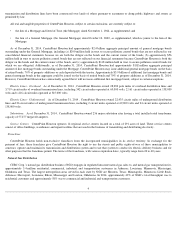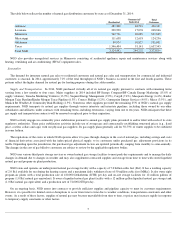CenterPoint Energy 2014 Annual Report Download - page 20
Download and view the complete annual report
Please find page 20 of the 2014 CenterPoint Energy annual report below. You can navigate through the pages in the report by either clicking on the pages listed below, or by using the keyword search tool below to find specific information within the annual report.
The recent trend in environmental regulation has been to place more restrictions and limitations on activities that may affect the
environment, and thus there can be no assurance as to the amount or timing of future expenditures for environmental compliance or remediation,
and actual future expenditures may be different from the amounts we currently anticipate. We try to anticipate future regulatory requirements
that might be imposed and plan accordingly to remain in compliance with changing environmental laws and regulations and to ensure the costs
of such compliance are reasonable.
Based on current regulatory requirements and interpretations, we do not believe that compliance with federal, state or local environmental
laws and regulations will have a material adverse effect on our business, financial position, results of operations or cash flows. In addition, we
believe that our current environmental remediation activities will not materially interrupt or diminish our operational ability. We cannot assure
you that future events, such as changes in existing laws, the promulgation of new laws, or the development or discovery of new facts or
conditions will not cause us to incur significant costs. The following is a discussion of material current environmental and safety laws and
regulations that relate to our operations. We believe that we are in substantial compliance with these environmental laws and regulations.
Global Climate Change
In recent years, there has been increasing public debate regarding the potential impact on global climate change by various “
greenhouse
gases” (
GHGs) such as carbon dioxide, a byproduct of burning fossil fuels, and methane, the principal component of the natural gas that we
transport and deliver to customers. The United States Congress has, from time to time, considered adopting legislation to reduce emissions of
GHGs, and there has been a wide-
ranging policy debate, both nationally and internationally, regarding the impact of these gases and possible
means for their regulation. Some of the proposals would require industrial sources to meet stringent new standards that would require substantial
reductions in carbon emissions. In addition, efforts have been made and continue to be made in the international community toward the adoption
of international treaties or protocols that would address global climate change issues. Following a finding by the U.S. Environmental Protection
Agency (EPA) that certain GHGs represent an endangerment to human health, the EPA adopted two sets of rules regulating GHG emissions
under the Clean Air Act. One requires a reduction in emissions of GHGs from motor vehicles beginning January 2, 2011. The other regulates
emissions of GHGs from certain large stationary sources under the Clean Air Act’
s Prevention of Significant Deterioration and Title V
programs, commencing when the motor vehicle standards took effect on January 2, 2011. Also, the EPA adopted its “
Mandatory Reporting of
Greenhouse Gases Rule”
that requires the annual calculation and reporting of GHG emissions from natural gas transmission, gathering,
processing and distribution systems and electric distribution systems that emit 25,000 metric tons or more of CO
2
equivalent per year. These
additional reporting requirements began in 2012 and we are currently in compliance. These permitting and reporting requirements could lead to
further regulation of GHGs by the EPA.
Although the adoption of new legislation is uncertain, action by the EPA to impose new standards and reporting requirements regarding
GHG emissions continues. On January 14, 2015, the EPA announced that it will issue a proposed rule in the summer of 2015 and a final rule in
2016 setting standards for methane and volatile organic compound (VOC) emissions from new and modified oil and gas production sources and
natural gas processing and transmission sources. As part of the same announcement, PHMSA stated that it will propose natural gas pipeline
safety standards in 2015 that are expected to reduce methane emissions. Furthermore, in December 2014, the EPA proposed changes to its GHG
reporting rule that would require additional reporting from natural gas transmission pipelines. In addition, many states and regions of the United
States have begun to regulate GHGs. CERC’
s revenues, operating costs and capital requirements could be adversely affected as a result of any
regulatory action that would require installation of new control technologies or a modification of its operations or would have the effect of
reducing the consumption of natural gas. Our electric transmission and distribution business, in contrast to some electric utilities, does not
generate electricity and thus is not directly exposed to the risk of high capital costs and regulatory uncertainties that face electric utilities that
burn fossil fuels to generate electricity. Nevertheless, CenterPoint Houston’
s revenues could be adversely affected to the extent any resulting
regulatory action has the effect of reducing consumption of electricity by ultimate consumers within its service territory. Likewise, incentives to
conserve energy or use energy sources other than natural gas could result in a decrease in demand for our services. Conversely, regulatory
actions that effectively promote the consumption of natural gas because of its lower emissions characteristics would be expected to beneficially
affect CERC and its natural gas-
related businesses. At this point in time, however, it would be speculative to try to quantify the magnitude of the
impacts from possible new regulatory actions related to GHG emissions, either positive or negative, on our businesses.
To the extent climate changes occur, our businesses may be adversely impacted, though we believe any such impacts are likely to occur very
gradually and hence would be difficult to quantify. To the extent global climate change results in warmer temperatures in our service territories,
financial results from our natural gas distribution businesses could be adversely affected through lower gas sales, and Enable’
s businesses could
experience lower revenues. On the other hand, warmer temperatures in our electric service territory may increase our revenues from
transmission and distribution through increased demand for electricity for cooling. Another possible effect of climate change is more frequent
and more severe weather events, such as hurricanes or tornadoes. Since many of our facilities are located along or near the Gulf Coast, increased
or more severe hurricanes or tornadoes
14
























